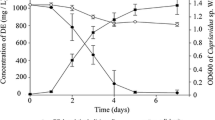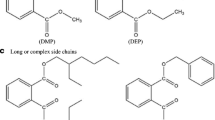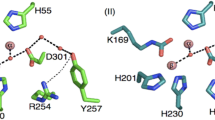Abstract
A related group of phosphotriesters known as organophosphate flame retardants (OPFRs) has become emerging contaminants due to its worldwide use. The lack of an easily hydrolysable bond renders OPFRs inert to the well-known phosphotriesterases capable of hydrolyzing the neurotoxic organophosphates. An OPFRs phosphotriesterase gene stpte was cloned from plasmid pStJH of strain Sphingopyxis terrae subsp. terrae YC-JH3 and was heterologously expressed in Escherichia coli. The recombinant protein St-PTE was purified and analyzed. St-PTE showed the highest catalytic activity at pH 8.5 and 35 °C. The optimal substrate for St-PTE is triphenyl phosphate, with kcat/Km of 5.03 × 106 M−1 s−1, two orders of magnitude higher than those of tricresyl phosphate (4.17 × 104 M−1 s−1), 2-ethylhexyl diphenyl phosphate (2.03 × 104 M−1 s−1) and resorcinol bis(diphenyl phosphate) (6.30 × 104 M−1 s−1). St-PTE could break the P–O bond of tri-esters and convert aryl-OPFRs into their corresponding di-ester metabolites, including polymers of resorcinol bis(diphenyl phosphate). Mediated by transposase, the gene of OPFRs phosphotriesterase could be transferred horizontally among closely related strains of Sphingomonas, Sphingobium and Sphingopyxis.
Graphical abstract

Key points
• St-PTE from Sphingopyxis terrae subsp. terrae YC-JH3 could hydrolyze aryl-OPFRs.
• Metabolites of RBDPP hydrolyzed by phosphotriesterase were identified.
• St-PTE could hydrolyze the P–O cleavage of dimer and trimer of RBDPP.
• Phosphotriesterase genes transfer among Sphingomonadaceae mediated by transposase.




Similar content being viewed by others
Data availability
All data generated or analyzed during this study are included in this published article (and its supplementary information files).
References
Abe K, Yoshida S, Suzuki Y, Mori J, Doi Y, Takahashi S, Kera Y, Parales RE (2014) Haloalkylphosphorus hydrolases purified from Sphingomonas sp. strain TDK1 and Sphingobium sp. strain TCM1. Appl Environ Microbiol [J] 80:5866–5873. https://doi.org/10.1128/AEM.01845-14
Ballesteros-gómez A, Erratico CA, Eede NVD, Ionas AC, Leonards PEG, Covaci A (2015) In vitro metabolism of 2-ethylhexyldiphenyl phosphate (EHDPHP) by human liver microsomes. Toxicol Lett [J] 232:203–212. https://doi.org/10.1016/j.toxlet.2014.11.007
Ballesteros-gómez A, Van Den Eede N, Covaci A (2015) In vitro human metabolism of the flame retardant resorcinol bis(diphenylphosphate) (RDP). Environ Sci Technol [J] 49:3897–3904. https://doi.org/10.1021/es505857e
Bigley AN, Narindoshvili T, Xiang DF, Raushel FM (2018) Multiple reaction products from the hydrolysis of chiral and prochiral organophosphate substrates by the phosphotriesterase from Sphingobium sp. TCM1. Biochemistry [j] 57:1842–1846. https://doi.org/10.1021/acs.biochem.8b00145
Bigley AN, Xiang DF, Narindoshvili T, Burgert CW, Hengge AC, Raushel FM (2019) Transition State Analysis of the Reaction Catalyzed by the Phosphotriesterase from Sphingobium sp. TCM1. Biochemistry [j] 58:1246–1259. https://doi.org/10.1021/acs.biochem.9b00041
Bigley AN, Narindoshvili T, Xiang DF, Raushel FM (2020) Stereoselective formation of multiple reaction products by the phosphotriesterase from Sphingobium sp. TCM1. Biochemistry [j] 59:1273–1288. https://doi.org/10.1021/acs.biochem.0c00089
Blum A, Behl M, Birnbaum LS, Diamond ML, Phillips A, Singla V, Sipes NS, Stapleton HM, Venier M (2019) Organophosphate ester flame retardants: are they a regrettable substitution for polybrominated diphenyl ethers? Environ Sci Technol Lett [J] 6:638–649. https://doi.org/10.1021/acs.estlett.9b00582
Brandsma SH, Sellström U, De Wit CA, De Boer J, Leonards PEG (2013) Dust measurement of two organophosphorus flame retardants, resorcinol bis(diphenylphosphate) (RBDPP) and bisphenol A bis(diphenylphosphate) (BPA-BDPP), used as alternatives for BDE-209. Environ Sci Technol [J] 47:14434–14441. https://doi.org/10.1021/es404123q
Chen M, Jiang J, Gan Z, Yan Y, Ding S, Su S, Bao X (2019) Grain size distribution and exposure evaluation of organophosphorus and brominated flame retardants in indoor and outdoor dust and PM10 from Chengdu, China. J Hazard Mater [J] 365:280–288. https://doi.org/10.1016/j.jhazmat.2018.10.082
Faiz Y, Siddique N, He H, Sun C, Waheed S (2018) Occurrence and profile of organophosphorus compounds in fine and coarse particulate matter from two urban areas of China and Pakistan. Environ Pollut [J] 233:26–34. https://doi.org/10.1016/j.envpol.2017.09.091
He C-T, Zheng J, Qiao L, Chen S-J, Yang J-Z, Yuan J-G, Yang Z-Y, Mai B-X (2015) Occurrence of organophosphorus flame retardants in indoor dust in multiple microenvironments of southern China and implications for human exposure. Chemosphere [j] 133:47–52. https://doi.org/10.1016/j.chemosphere.2015.03.043
Kauffman KM, Hussain FA, Yang J, Arevalo P, Brown JM, Chang WK, Vaninsberghe D, Elsherbini J, Sharma RS, Cutler MB, Kelly L, Polz MF (2018) A major lineage of non-tailed dsDNA viruses as unrecognized killers of marine bacteria. Nature [j] 554:118–122. https://doi.org/10.1038/nature25474
Kwon B, Shin H, Moon H-B, Ji K, Kim K-T (2016) Effects of tris(2-butoxyethyl) phosphate exposure on endocrine systems and reproduction of zebrafish (Danio rerio). Environ Pollut [J] 214:568–574. https://doi.org/10.1016/j.envpol.2016.04.049
Lee S, Jeong W, Kannan K, Moon H-B (2016) Occurrence and exposure assessment of organophosphate flame retardants (OPFRs) through the consumption of drinking water in Korea. Water Res [J] 103:182–188. https://doi.org/10.1016/j.watres.2016.07.034
Li J, Xie Z, Mi W, Lai S, Tian C, Emeis K-C, Ebinghaus R (2017) Organophosphate esters in air, snow, and seawater in the North Atlantic and the Arctic. Environ Sci Technol [J] 51:6887–6896. https://doi.org/10.1021/acs.est.7b01289
Li T-Y, Bao L-J, Wu C-C, Liu L-Y, Wong CS, Zeng EY (2019) Organophosphate flame retardants emitted from thermal treatment and open burning of e-waste. J Hazard Mater [J] 367:390–396. https://doi.org/10.1016/j.jhazmat.2018.12.041
Li X, Reheman A, Wu W, Wang D, Wang J, Jia Y, Yan Y (2020) The genome analysis of halotolerant Sphingobium yanoikuyae YC-XJ2 with aryl organophosphorus flame retardants degrading capacity and characteristics of related phosphotriesterase. Int Biodeterior Biodegradation [J] 155:105064. https://doi.org/10.1016/j.ibiod.2020.105064
Li Y, Kang Q, Chen R, He J, Liu L, Wang L, Hu J (2020) 2-Ethylhexyl diphenyl phosphate and its hydroxylated metabolites are anti-androgenic and cause adverse reproductive outcomes in male Japanese medaka (Oryzias latipes). Environ Sci Technol [J] 54:8919–8925. https://doi.org/10.1021/acs.est.0c02775
Liu X, Cai Y, Wang Y, Xu S, Ji K, Choi K (2019) Effects of tris(1,3-dichloro-2-propyl) phosphate (TDCPP) and triphenyl phosphate (TPP) on sex-dependent alterations of thyroid hormones in adult zebrafish. Ecotoxicol Environ Saf [J] 170:25–32. https://doi.org/10.1016/j.ecoenv.2018.11.058
Ma H, Ishida K, Xu C, Takahashi K, Li Y, Zhang C, Kang Q, Jia Y, Hu W, Matsumaru D, Nakanishi T, Hu J (2021) Triphenyl phosphate delayed pubertal timing and induced decline of ovarian reserve in mice as an estrogen receptor antagonist. Environ Pollut [J] 290:118096. https://doi.org/10.1016/j.envpol.2021.118096
Mabanglo MF, Xiang DF, Bigley AN, Raushel FM (2016) Structure of a novel phosphotriesterase from Sphingobium sp. TCM1: a familiar binuclear metal center embedded in a seven-bladed β-propeller protein fold. Biochemistry [j] 55:3963–3974. https://doi.org/10.1021/acs.biochem.6b00364
Mcgee SP, Konstantinov A, Stapleton HM, Volz DC (2013) Aryl phosphate esters within a major pentaBDE replacement product induce cardiotoxicity in developing zebrafish embryos: potential role of the aryl hydrocarbon receptor. Toxicol Sci [J] 133:144–156. https://doi.org/10.1093/toxsci/kft020
Möller A, Sturm R, Xie Z, Cai M, He J, Ebinghaus R (2012) Organophosphorus flame retardants and plasticizers in airborne particles over the Northern Pacific and Indian Ocean toward the polar regions: evidence for global occurrence. Environ Sci Technol [J] 46:3127–3134. https://doi.org/10.1021/es204272v
Salamova A, Ma Y, Venier M, Hites RA (2014) High levels of organophosphate flame retardants in the Great Lakes atmosphere. Environ Sci Technol Lett [J] 1:8–14. https://doi.org/10.1021/ez400034n
Shi Y, Gao L, Li W, Wang Y, Liu J, Cai Y (2016) Occurrence, distribution and seasonal variation of organophosphate flame retardants and plasticizers in urban surface water in Beijing, China. Environ Pollut [J] 209:1–10. https://doi.org/10.1016/j.envpol.2015.11.008
Shi Q, Wang M, Shi F, Yang L, Guo Y, Feng C, Liu J, Zhou B (2018) Developmental neurotoxicity of triphenyl phosphate in zebrafish larvae. Aquat Toxicol [J] 203:80–87. https://doi.org/10.1016/j.aquatox.2018.08.001
Shi Q, Wang Z, Chen L, Fu J, Han J, Hu B, Zhou B (2019) Optical toxicity of triphenyl phosphate in zebrafish larvae. Aquat Toxicol [J] 210:139–147. https://doi.org/10.1016/j.aquatox.2019.02.024
Stapleton HM, Misenheimer J, Hoffman K, Webster TF (2014) Flame retardant associations between children’s handwipes and house dust. Chemosphere [j] 116:54–60. https://doi.org/10.1016/j.chemosphere.2013.12.100
Sun W, Duan X, Chen H, Zhang L, Sun H (2020) Adipogenic activity of 2-ethylhexyl diphenyl phosphate via peroxisome proliferator-activated receptor γ pathway. Sci Total Environ [J] 711:134810. https://doi.org/10.1016/j.scitotenv.2019.134810
Van Der Veen I, De Boer J (2012) Phosphorus flame retardants: properties, production, environmental occurrence, toxicity and analysis. Chemosphere [j] 88:1119–1153. https://doi.org/10.1016/j.chemosphere.2012.03.067
Wang R, Tang J, Xie Z, Mi W, Chen Y, Wolschke H, Tian C, Pan X, Luo Y, Ebinghaus R (2015) Occurrence and spatial distribution of organophosphate ester flame retardants and plasticizers in 40 rivers draining into the Bohai Sea, north China. Environ Pollut [J] 198:172–178. https://doi.org/10.1016/j.envpol.2014.12.037
Wang Y, Wu X, Zhang Q, Hou M, Zhao H, Xie Q, Du J, Chen J (2017) Organophosphate esters in sediment cores from coastal Laizhou Bay of the Bohai Sea, China. Sci Total Environ [J] 607–608:103–108. https://doi.org/10.1016/j.scitotenv.2017.06.259
Wang J, Khokhar I, Ren C, Li X, Wang J, Fan S, Jia Y, Yan Y (2019) Characterization and 16S metagenomic analysis of organophosphorus flame retardants degrading consortia. J Hazard Mater [J] 380:120881. https://doi.org/10.1016/j.jhazmat.2019.120881
Wang J, Hlaing TS, Nwe MT, Aung MM, Ren C, Wu W, Yan Y (2021) Primary biodegradation and mineralization of aryl organophosphate flame retardants by Rhodococcus-Sphingopyxis consortium. J Hazard Mater [J] 412:125238. https://doi.org/10.1016/j.jhazmat.2021.125238
Wang L-M, Luo D, Li X, Hu L-Q, Chen J-X, Tu Z-Z, Sun B, Chen H-G, Liu L, Yu M, Li Y-P, Pan A, Messerlian C, Mei S-R, Wang Y-X (2021) Temporal variability of organophosphate flame retardant metabolites in spot, first morning, and 24-h urine samples among healthy adults. Environ Res [J] 196:110373. https://doi.org/10.1016/j.envres.2020.110373
Wang Y, Hong J, Shi M, Guo L, Liu L, Tang H, Liu X (2021) Triphenyl phosphate disturbs the lipidome and induces endoplasmic reticulum stress and apoptosis in JEG-3 cells. Chemosphere [j] 275:129978. https://doi.org/10.1016/j.chemosphere.2021.129978
Wei G-L, Li D-Q, Zhuo M-N, Liao Y-S, Xie Z-Y, Guo T-L, Li J-J, Zhang S-Y, Liang Z-Q (2015) Organophosphorus flame retardants and plasticizers: sources, occurrence, toxicity and human exposure. Environ Pollut [J] 196:29–46. https://doi.org/10.1016/j.envpol.2014.09.012
Wei K, Yin H, Peng H, Lu G, Dang Z (2018) Bioremediation of triphenyl phosphate by Brevibacillus brevis: degradation characteristics and role of cytochrome P450 monooxygenase. Sci Total Environ [J] 627:1389–1395. https://doi.org/10.1016/j.scitotenv.2018.02.028
Wolschke H, Sühring R, Xie Z, Ebinghaus R (2015) Organophosphorus flame retardants and plasticizers in the aquatic environment: a case study of the Elbe River, Germany. Environ Pollut [J] 206:488–493. https://doi.org/10.1016/j.envpol.2015.08.002
Xiang DF, Bigley AN, Ren Z, Xue H, Hull KG, Romo D, Raushel FM (2015) Interrogation of the substrate profile and catalytic properties of the phosphotriesterase from Sphingobium sp. strain TCM1: an enzyme capable of hydrolyzing organophosphate flame retardants and plasticizers. Biochemistry [j] 54:7539–7549. https://doi.org/10.1021/acs.biochem.5b01144
Xiang P, Liu R-Y, Li C, Gao P, Cui X-Y, Ma LQ (2017) Effects of organophosphorus flame retardant TDCPP on normal human corneal epithelial cells: implications for human health. Environ Pollut [J] 230:22–30. https://doi.org/10.1016/j.envpol.2017.06.036
Yadav IC, Devi NL, Li J, Zhang G, Covaci A (2018) Concentration and spatial distribution of organophosphate esters in the soil-sediment profile of Kathmandu Valley, Nepal: Implication for risk assessment. Sci Total Environ [J] 613:502–512. https://doi.org/10.1016/j.scitotenv.2017.09.039
Yuan S, Li H, Dang Y, Liu C (2018) Effects of triphenyl phosphate on growth, reproduction and transcription of genes of Daphnia magna. Aquat Toxicol [J] 195:58–66. https://doi.org/10.1016/j.aquatox.2017.12.009
Zhang Q, Ji S, Chai L, Yang F, Zhao M, Liu W, Schüürmann G, Ji L (2018) Metabolic mechanism of aryl phosphorus flame retardants by cytochromes P450: a combined experimental and computational study on triphenyl phosphate. Environ Sci Technol [J] 52:14411–14421. https://doi.org/10.1021/acs.est.8b03965
Zhong M, Tang J, Mi L, Li F, Wang R, Huang G, Wu H (2017) Occurrence and spatial distribution of organophosphorus flame retardants and plasticizers in the Bohai and Yellow Seas, China. Mar Pollut Bull [J] 121:331–338. https://doi.org/10.1016/j.marpolbul.2017.06.034
Funding
This study was funded by the National Natural Science Foundation of China (31540067, 21876201) and the Basic Research Fund of Chinese Academy of Agricultural Sciences (1610042018005 and 1610042018006).
Author information
Authors and Affiliations
Contributions
WJ conceived and designed research. WJ and YL conducted experiments. WW and YY contributed new reagents or analytical tools. WJ analyzed data. WJ wrote the manuscript. All authors read and approved the manuscript.
Corresponding authors
Ethics declarations
Ethics approval
This article does not contain any studies with human participants performed by any of the authors.
Conflict of interest
The authors declare no competing interests.
Additional information
Publisher's note
Springer Nature remains neutral with regard to jurisdictional claims in published maps and institutional affiliations.
Supplementary Information
Below is the link to the electronic supplementary material.
Rights and permissions
Springer Nature or its licensor holds exclusive rights to this article under a publishing agreement with the author(s) or other rightsholder(s); author self-archiving of the accepted manuscript version of this article is solely governed by the terms of such publishing agreement and applicable law.
About this article
Cite this article
Wang, J., Yuan, L., Wu, W. et al. Characterization of the phosphotriesterase capable of hydrolyzing aryl-organophosphate flame retardants. Appl Microbiol Biotechnol 106, 6493–6504 (2022). https://doi.org/10.1007/s00253-022-12127-2
Received:
Revised:
Accepted:
Published:
Issue Date:
DOI: https://doi.org/10.1007/s00253-022-12127-2




